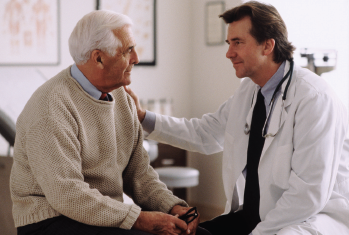Our patients are more than just their disease—they are parents, spouses, and children, all struggling to find meaning in their lives and achieve some level of happiness and health.
Explore This Issue
December 2020
As you shake his hand and introduce yourself, you notice he’s missing the distal fingertips of his right hand, and you observe atrophy of the helices of both ears, findings the resident may have missed. Indeed, there is a lesion on the upper lip, which on closer inspection with a dermatoscope appears to be a classic basal cell carcinoma. However, before you discuss the diagnostic and management options of the lesion, you inquire of the patient what happened to his ears and fingertips. He looks at you quizzically. “Frostbite,” he answers.
“What were the circumstances?” you press.
“Are you interested out of curiosity, Doc, or do you have a theory?”
“A little of both, I guess.”
“You been in the military, doc?”
When you answer “yes,” he asks, “Any combat deployments?”
“Two,” you answer.
“Okay, then. Marines, Chosin Reservoir, Korea, November 27 to December 13, 1950, then as a forced guest of the Chinese Communists until I escaped.”
(You sneak a closer look at the electronic health record and see that Marine Gunnery Sergeant Dennis was awarded the Navy Cross, the Silver Star, the Purple Heart, and the Prisoner of War Medal.)
“It’s a great honor to meet you, Gunny,” you say. “For the sake of this young resident, what lessons have you learned during your time in active service?”
“Every human life has meaning. Every life deserves respect and dignity. Be courteous to others. And you keep persisting, no matter what, to the end. Believe in a Higher Power, because we can’t do it alone. And, don’t complain when life gets hard. That’s when we learn what we’re really made of.”
What ethical lessons have these patients taught their doctors?
Discussion

© Getty Images
Too often we take for granted the impact our patients have on our lives and fail to learn valuable humanistic lessons from them. Certainly, we’re quite aware of their undoubtedly important contributions to our knowledge of pathophysiology and normal vs. abnormal findings. Yet, we don’t always appreciate that what we learn from them about human nature can be of equal value with what we learn medically.
We live and work in the realm of human beings. We make recommendations to, and facilitate shared decision-making with, individuals who are emotionally and cognitively complex and face complicated challenges in their life’s relationships—just like us. Perhaps the most important lessons we can learn from our patients are related to humanism, where our observations of their human interactions and behavior provide invaluable information we need to care for them. The revered patient-physician relationship, so fundamental to the entire notion of caring for others, can be a mirror reflecting our own capabilities and failings.
My first impactful lesson in respect for patients as people occurred in my gross anatomy class, where my professor (a physician and international anatomist) taught that individuals should always be respected, in life and in death. My cadaver was himself a former professor of anatomy at a major medical school in the Midwest who had donated his body for our learning as a final act of educational generosity. At every dissection session, we were reminded that, as future physicians, we were expected to understand that our patients, in life and in death, provide an unbelievably rich opportunity to learn about not only the intricacies of the human body, but also their humanity.
Each patient contact, even during short interactions, adds to our growing appreciation of the complexity of human nature, emotions, and communication. In medical school and during residency, we learned about disease from the microscopic to the macroscopic. But learning about human nature takes a lifetime of experience and exposure.
Some of our education about human nature and communication is subliminal, not quite on the surface enough to verbalize or quantify. The rest can be measured and is informative, if we take the time to listen, observe, and interact.
Our patients are more than just their disease—they’re parents, spouses, and children, all struggling to find meaning in their lives and achieve some level of happiness and health. They are us, and we are them. We care for easy and difficult patients, and we share human fragility with them. The more we understand their presentations of anger, sadness, fear, happiness, and other human emotions, the more empathetic and capable we can become as physicians. We can learn directly from our patients what we’re doing well and where we need improvement.
The ethics of professionalism identify a number of traits and virtues that are expected to be exemplified in physicians’ personal and professional lives. These include, in part, excellence, compassion and caring, empathy, honesty, moral courage, kindness, judgment, selflessness, and humanism. The practice of medicine is just that—practice. While the majority of these exemplary traits are inculcated early in our lives, there’s still plenty of room for improvement and expression through the years. How patients view us, how they respond to us, and how they show us where we need to improve all have fundamental value. Our patients can make us better people and physicians if we listen, observe, contemplate, and improve.